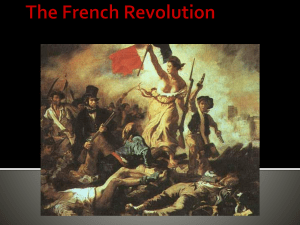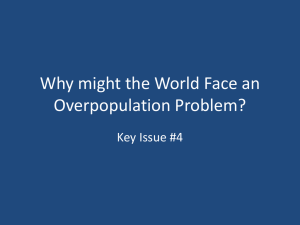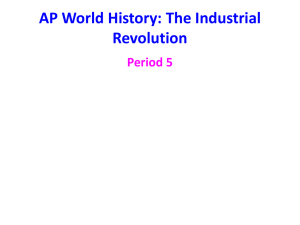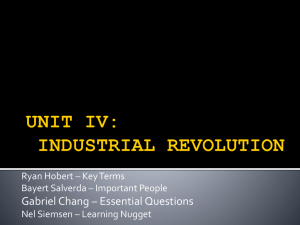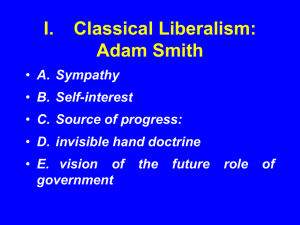Images from the Industrial Revolution
advertisement
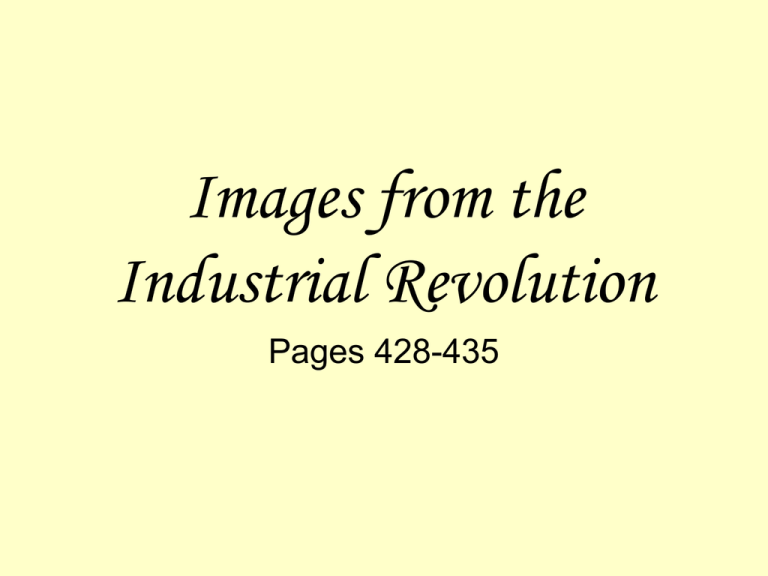
Images from the Industrial Revolution Pages 428-435 Objectives • Identify the impact of the Agricultural Revolution and the Enclosure laws. • Understand the advantages that England possessed as a leader in the Industrial Revolution. • Why was the Industrial Revolution both good and bad for human beings? • What were the main ideas of Malthus? • In what ways did some reformers try to mitigate (or lessen) the impact of the Industrial Revolution on human beings? Before the Industrial Revolution occurs, there is a great improvement in food production. Common lands are enclosed; larger farms are created Better food production methods are developed. Nitrogen was recognized as an important fertilizer. Turnips and clover replaced lost nutrients. Science and Agriculture merged. With food supplies increased, the population grows. The great scourges of the Plague diminish with better sanitation and stone and brick buildings… Small pox remains a killer, but it too will decrease as methods of inoculation and vaccination are used. The Industrial Revolution begins in Britain… A country with many advantages…sitting on huge iron ore and coal deposits… A country with many rivers and streams…so water power can be harnessed. A country with a mighty navy and overseas colonies… And finally, Great Britain is an island nation with a relatively stable constitutional monarchy. The first inventions are in the textile industry. With the increased population, the demand for cloth was great. The domestic system meant that spinning and weaving was farmed out at home… As you can imagine, this production capacity was limited. There were several inventions that occurred one after the other. All were considered innovative-- The Flying shuttle 1733 The spinning Jenny…1760’s The Water Frame 1769 And in America… the Cotton Gin As the machinery of cloth production became larger and more cumbersome, mills were built along streams, and workers flocked to the mills.. Salem, Oregon has an outstanding example of a Mill at the Mission Mill Museum. Rivers and Streams were great for making “power”—but they do dry up in the summer… So, steam became a source of energy around 1780. Steam.. The next frontier. First harnessed in 1702 by Thomas Newcomen, then improved by Thomas Wyatt. Legend has it that Thomas Wyatt first noticed the power of steam when he observed his mother’s tea kettle. But steam must be produced by heat, and by this time, wood was dwindling in England’s once great forests. And wood that remained was needed for Britain’s powerful navy. Thus, coal begins to be used in great amount—but do to Newcomen’s steam engine which drives the pumps that get the water out of the mines… See how this all ties together? It is this reciprocal inventiveness that really makes it an Industrial Revolution. Steam was soon used to “move” across areas, boats…and in 1829, The ROCKET! The first locomotive. Railroads changed the landscape. Early on, there were the gauge wars—a famous dispute about how far apart tracks should be. The smaller distance won—and as a result, railroad cars were less stable. Villages grew into towns, and towns grew into cities. Manchester, Liverpool, Leeds are all industrial cities. Workers crammed into housing so that they could be close enough to hear the “whistle” which announced the workday. Skilled labor or weavers and spinners was all replaced by machine—machines that produced far better quality goods. Some suggested smashing the machines that took away their work. The reverend Ludd encouraged this. His followers were called Luddites. Even today, a “Luddite” is someone who does not embrace change. In 1776, Adam Smith, an English economist observed the inventions and change occurring. He wrote a monumental book called The Wealth of Nations. He predicted that workers were at the mercy of the law of supply and demand. Competition and Free Trade would rule the future. Capitalists were seen as greedy. The truth was, many were bewildered themselves by the forces of an unregulated cuthroat marketplace… The first years of the Industrial Revolution were, for the most part, a horror story. Workers, desperate for employment, struggled to survive. Children worked 1214 hour days. Young children were maimed in the mines and in the mills. "There was a young woman, Sarah Goodling, who was poorly and so she stopped her machine. James Birch, the overlooker, knocked her to the floor. She got up as well as she could. He knocked her down again. Then she was carried to the apprentice house. Her bed-fellow found her dead in bed.” There was no organized labor, only random mob violence. At the beginning of the Industrial Revolution, it was unrestrained capitalism and unsafe working conditions. All of this misery was observed by two important men: Malthus and Ricardo. Malthus said that mankind was condemned to overpopulation and “checks” on the population by war, famine, disease and mother nature (earthquakes, floods, drought) Though not a cruel man, his underlying idea was that one should not improve the lot of man, because if things get better, they will just “breed” more. As the population grows, this will result in another cycle of “checks” by famine, disease, wars and mother nature. So, said Malthus: don’t make things better. If its too good people will have more kids—and the cycle will repeat itself. Malthus could not foresee that in the Industrial World, people would begin to limit the size of their families as health and education improved. Also, as the economy expanded, even large families would be successful—and many of your grandparents came from families of 7 or more children. But sadly, in the Global South, Malthus has proved right. Hunger, disease, warfare, drought and natural disasters have killed billions. AIDS is a good example of a disease that is “checking” the population of Africa. Ricardo was a “sidekick” of Malthus. He spoke of an “Iron Law” of wages: when there are too many workers, wages go down. But when there are fewer workers, wages go up. Malthus and Ricardo were the dreary prophets of the Industrial Revolution— Malthus being the most famous. Because Malthus has proven to be right—in the more miserable areas of the world, his name has become synonymous with “Malthusian” ideas of doom for mankind and its burgeoning population. As we study the political history of Europe in the 1800s, we must always remember that the Industrial Revolution is ongoing. It spreads to continental Europe and America. Textiles, Steam, and Railroads, make way for electricity, the internal combustion engine, gas (cars) and steel (skyscrapers) All of your ancestors suffered through this time. Mrs. Olsen’s great great grandmother was found begging for food for her children on the streets of Stockholm, Sweden, in 1840. There was no work, few social programs… But, things will improve. Great leaders, both men and women will transform how we look at human beings and the world. Thus the 1800s is really the most significant century we will study. Because somewhere around 1800 people lived, or were born, who would take it upon themselves, to make life better for others—this humanitarianism of both men and women, we will learn about soon. It is as if a “light” was switched on in Western Civilization: that humans must look around them and see their capacity to improve others’ lives with social and economic reforms.



